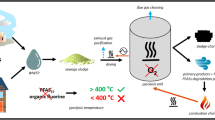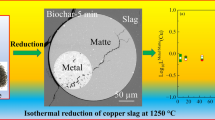Abstract
Different batches of valued mussel shell and waste mussel shell ash are characterised. Shell ash has pH > 12 and high electrical conductivities (between 16.01 and 27.27 dS m−1), while calcined shell shows pH values up to 10.7 and electrical conductivities between 1.19 and 3.55 dS m−1. X-ray fluorescence, nitric acid digestion and water extractions show higher concentrations in shell ash for most parameters. Calcite is the dominant crystalline compound in this ash (95.6 %), followed by aragonite. Adsorption/desorption trials were performed for mussel shell ash and for a waste mixture including shell ash, sewage sludge and wood ash, showing the following percentage adsorptions: Hg(II) >94 %, As(V) >96 % and Cr(VI) between 11 and 30 % for shell ash; Hg(II) >98 %, As(V) >88 % and Cr(VI) between 30 and 88 % for the waste mixture. Hg and As desorption was <5 % for both shell ash and the waste mixture, while Cr desorption was between 92 and 45 % for shell ash, and between 19 and 0 % for the mixture. In view of that, mussel shell ash and the mixture including shell ash, sewage sludge and wood ash could be useful for Hg(II) and As(V) removal.



Similar content being viewed by others
References
Abeynaike A, Wang L, Jones MI, Patterson DA (2011) Pyrolysed powdered mussel shells for eutrophication control: effect of particle size and powder concentration on the mechanism and extent of phosphate removal. Asia Pac J Chem Eng 6(2):231–243
Aksu Z, Akpinar D (2001) Competitive biosorption of phenol and chromium(VI) from binary mixtures onto dried anaerobic activated sludge. Biochem Eng J 7:183–193
Alexandratos VG, Elzinga EJ, Reeder RJ (2007) Arsenate uptake by calcite: macroscopic and spectroscopic characterization of adsorption and incorporation mechanisms. Geochim Cosmochim Acta 71:4172–4187
Ali I, Gupta VK (2007) Advances in water treatment by adsorption technology. Nat Protoc 1(6):2661–2667
Álvarez E, Fernández-Sanjurjo MJ, Núñez-Delgado A, Seco N, Corti G (2012a) Aluminium fractionation and speciation in bulk and rhizosphere of a grass soil amended with mussel shells or lime. Geoderma 173–174:322–329
Álvarez E, Fernández-Sanjurjo MJ, Seco N, Núñez-Delgado A (2012b) Use of mussel shells as a soil amendment: effects on bulk and rhizosphere soil, and pasture production. Pedosphere 22:152–164
Arnesen AKM, Krogstad T (1998) Sorption and desorption of fluoride in soil polluted from the aluminium smelter at Ardal in Western Norway. Water Air Soil Pollut 103:357–373
Barros MC, Magán A, Valiño S, Bello PM, Casares JJ, Blanco JM (2009) Identification of best available techniques in the seafood industry: a case study. J Clean Prod 17:391–399
Boddu VM, Abburi K, Talbott JL, Smith ED (2003) Removal of hexavalent chromium from wastewater using a new composite chitosan biosorbent. Environ Sci Technol 37(19):4449–4456
Cetinkaya G, Aksu Z, Ozturk A, Kutsal T (1999) A comparative study on heavy metal biosorption characteristics of some algae. Process Biochem 34:885–892
Cubillas P, Köhler S, Prieto M, Causserand C, Oelkers EH (2005) How do mineral coatings affect dissolution rates? An experimental study of coupled CaCO3 dissolution–CdCO3 precipitation. Geochim Cosmochim Acta 69(23):5459–5476
Currie JA, Harrison NR, Wang L, Jones MI, Brooks MS (2007) A preliminary study of processing seafood shells for eutrophication control. Asia Pac J Chem Eng 2:460–467
Dizadji N, Abootalebi Anaraki N (2011) Adsorption of chromium and copper in aqueous solutions using tea residue. Int J Environ Sci Tech 8(3):631–638
Drexel RT, Haitzer M, Ryan JN, Aiken GR, Nagy KL (2002) Mercury(II) sorption to two Florida everglades peats: evidence for strong and weak binding and competition by dissolved organic matter released from the peat. Environ Sci Technol 36:4058–4064
Fernández-González R, Martínez-Carballo E, González-Barreiro C, Rial-Otero R, Simal-Gándara J (2011) Distribution of polychlorinated biphenyls in both products and by-products of a mussel shell incinerator facility. Environ Sci Pollut Res 18(7):1139–1146
Gupta VK, Ali I (2004) Removal of lead and chromium from wastewater using bagasse fly ash—a sugar industry waste. J Colloid Interface Sci 271:321–328
Gupta VK, Rastogi A (2008a) Biosorption of lead(II) from aqueous solutions by non-living algal biomass Oedogonium sp. and Nostoc sp.—a comparative study. Colloid Surf B 64(2):170–178
Gupta VK, Rastogi A (2008b) Sorption and desorption studies of chromium(VI) from nonviable cyanobacterium Nostoc muscorum biomass. J Hazard Mater 154(1–3):347–354
Gupta VK, Rastogi A (2008c) Equilibrium and kinetic modelling of cadmium(II) biosorption by nonliving algal biomass Oedogonium sp. from aqueous phase. J Hazard Mater 153(1–2):759–766
Gupta VK, Rastogi A (2009) Biosorption of hexavalent chromium by raw and acid-treated green alga Oedogonium hatei from aqueous solutions. J Hazard Mater 163:396–402
Gupta VK, Sharma S (2002) Removal of cadmium and zinc from aqueous solutions using red mud. Environ Sci Technol 36(16):3612–3617
Gupta VK, Srivastava SK, Mohan D, Sharma S (1997) Design Parameters for fixed bed reactors of activated carbon developed from fertilizer waste material for the removal of some heavy metal ions. Waste Manage 17:517–522
Gupta VK, Mittal A, Gajbe V, Mittal J (2006) Removal and recovery of the hazardous azo dye acid orange 7 through adsorption over waste materials: bottom ash and de-oiled soya. Ind Eng Chem Res 45(4):1446–1453
Gupta VK, Jain R, Varshney S (2007a) Removal of Reactofix golden yellow 3 RFN from aqueous solution using wheat husk—an agricultural waste. J Hazard Mater 142(1–2):443–448
Gupta VK, Jain R, Mittal A, Mathur M, Sikarwar S (2007b) Photochemical degradation of the hazardous dye Safranin-T using TiO2 catalyst. J Colloid Interface Sci 309(2):464–469
Gupta VK, Rastogi A, Nayak A (2010) Adsorption studies on the removal of hexavalent chromium from aqueous solution using a low cost fertilizer industry waste material. J Colloid Interface Sci 342(1):135–141
Iribarren D, Moreira MT, Feijoo G (2010) Implementing by-product management into the life cycle assessment of the mussel sector. Resour Conserv Recycl 54:1219–1230
Köhler S, Cubillas P, Rodríguez-Blanco JD, Bauer C, Prieto M (2007) Removal of cadmium from wastewaters by aragonite shells and the influence of other divalent cations. Environ Sci Technol 41:112–118
Lin YT, Huang CP (2008) Reduction of chromium(VI) by pyrite in dilute aqueous solutions. Sep Purif Technol 63(1):191–199
Mahuli SK, Agnihotri R, Chauk S, Ghosh-Dastida A, Wei SH, Fan LS (1997) Pore-structure optimization of calcium carbonate for enhanced sulfation. AICHE J 43(9):2323–2335
Maji SK, Pal A, Pal T, Adak A (2007) Adsorption thermodynamics of arsenic on laterite soil. J Surf Sci Technol 22:161–176
Mohan D, Gupta VK, Srivastava SK, Chander S (2001) Kinetics of mercury adsorption from wastewater using activated carbon derived from fertilizer waste. Colloids Surf A 177:169–181
Peña-Rodríguez S, Fernández-Calviño D, Nóvoa-Muñoz JC, Arias-Estévez M, Núñez-Delgado A, Fernández-Sanjurjo MJ, Álvarez-Rodríguez E (2010) Kinetics of Hg(II) adsorption and desorption in calcined mussel shells. J Hazard Mater 180:622–627
Pérez-Gregorio MR, García-Falcón MS, Martínez-Carballo E, Simal-Gándara J (2010) Removal of polycyclic aromatic hydrocarbons from organic solvents by ashes wastes. J Hazard Mater 178:273–281
Pousada-Ferradás Y, Seoane-Labandeira S, Blanco M, Núñez-Delgado A (2011) The effect of aging on element plant availability and bacterial counts of mixtures of wood ash and sewage sludge. Maderas-Cienc Tecnol 13(3):307–318
Pousada-Ferradás Y, Seoane-Labandeira S, Mora-Gutiérrez A, Núñez-Delgado A (2012) Risk of water pollution due to ash–sludge mixtures: column trials. Int J Environ Sci Tech 9(1):21–29
Prieto M, Cubillas P, Fernández-González A (2003) Uptake of dissolved Cd by biogenic and abiogenic aragonite: a comparison with sorption onto calcite. Geochim Cosmochim Acta 67(20):3859–3869
Sakulkhaemaruethai S, Duangduen C, Pivsa-Art W, Pivsa-Art S (2010) Fabrication of composite material from sea mussel shells and white clay as a versatile sorbent. Energy Res J 1(2):78–81
Tan KH (1996) Soil sampling, preparation and analysis. Marcel Decker, New York
Ucun H, Bayhan YK, Kaya Y, Cakici A, Algur OF (2002) Biosorption of chromium (VI) from aqueous solution by cone biomass of Pinus sylvestris. Bioresour Technol 85(2):155–158
Vinodhini V, Nilanjana D (2009) Biowaste materials as sorbents to remove chromium(VI) from aqueous environment a comparative study. J Agric Biol Sci 4:19–23
Wang XS, Li ZZ, Tao SR (2009) Removal of chromium(VI) from aqueous solution using walnut hull. J Environ Manage 90:721–729
Acknowledgments
This work was funded by the Government of Galicia (Spain).
Author information
Authors and Affiliations
Corresponding author
Additional information
Responsible editor: Vera Slaveykova
Electronic supplementary material
Below is the link to the electronic supplementary material.
Fig. S1 1
pH value for shell ash and the waste mixture as a function of adsorbed arsenic (a), chromium (b) and mercury (c). Bars indicate standard deviation, with coefficients of variation always ≤ 5% (XLSX 57 kb)
Rights and permissions
About this article
Cite this article
Seco-Reigosa, N., Peña-Rodríguez, S., Nóvoa-Muñoz, J.C. et al. Arsenic, chromium and mercury removal using mussel shell ash or a sludge/ashes waste mixture. Environ Sci Pollut Res 20, 2670–2678 (2013). https://doi.org/10.1007/s11356-012-1192-6
Received:
Accepted:
Published:
Issue Date:
DOI: https://doi.org/10.1007/s11356-012-1192-6




